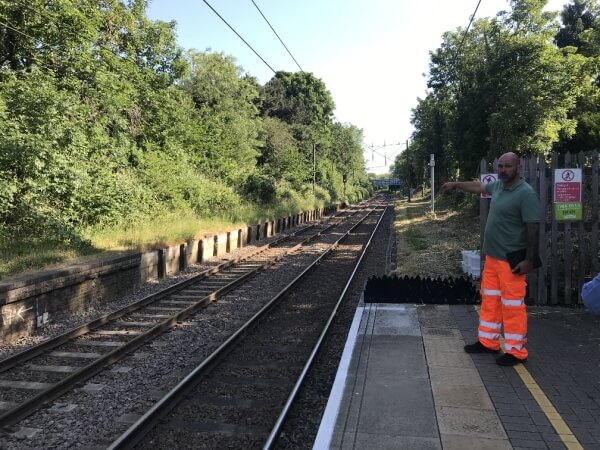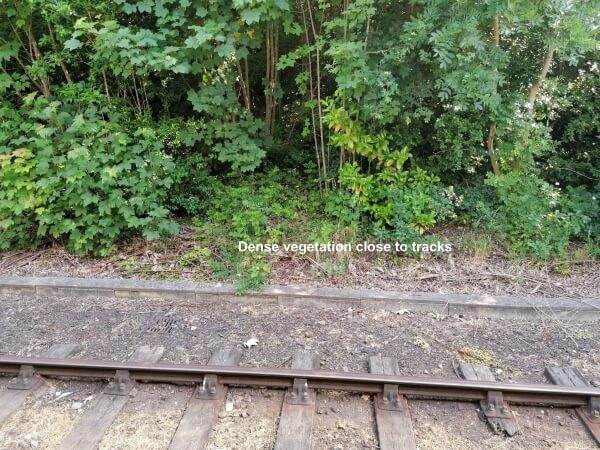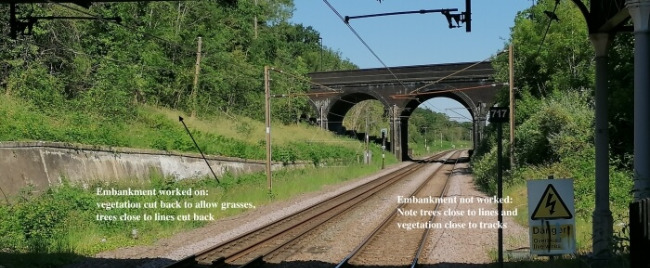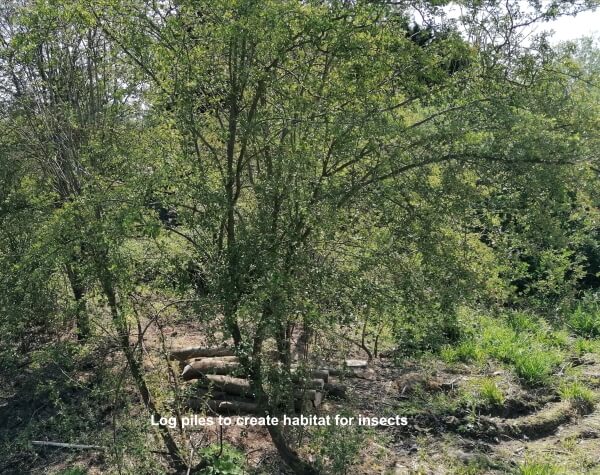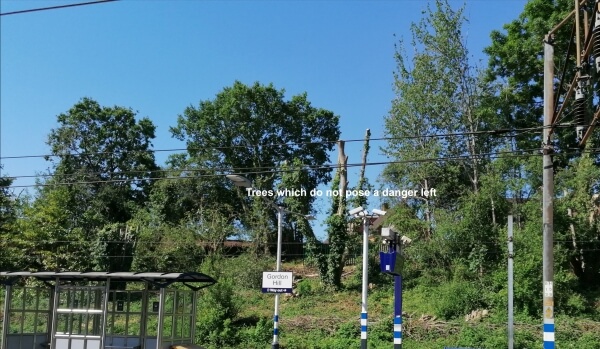Forum topic: Network Rail and lineside vegetation: Turning over a new leaf
Managing vegetation alongside the railway - a new approach pioneered in PG
07 Jun 2020 11:03 - 07 Jun 2020 16:17 #5369- Karl Brown
Share
![]()
![]()
 Email
Email
Another chainsaw led attack of the rail embankment led to a telephone conversation, a trip from Barnsley by the project lead and a detailed explanatory tour of the still ongoing work for Lakes Conservation Area and FLDRA Committee member, Ibrar, plus my horticulturalist wife. This time it turns out to be a positive story, one where PG will be central to the UK pilot and the work seems to be in very good hands. Not all sweetness and light however as it seems four, presumably displaced squirrels, are now fighting between themselves for territorial rights over our garden. Story is here:
https://www.gardenmusing-annejennings.com/post/walk-on-the-wild-side
https://www.gardenmusing-annejennings.com/post/walk-on-the-wild-side
Please Log in or Create an account to join the conversation.
Managing vegetation alongside the railway - a new approach pioneered in PG
10 Jun 2020 23:07 #5372- PGC Webmaster
Share
![]()
![]()
 Email
Email
Karl's earlier post includes a link to a more detailed account on Garden Musing, a blog maintained by Anne Jennings, an award-winning garden designer and horticulturalist. Because the formatting of the blog makes it difficult for some people to read, I've reposted the account, which you can find at www.gardenmusing-annejennings.com/post/walk-on-the-wild-side.
The photo shows a section of track at the rear of Devonshire Road and the arboriculturalist employed by Network Rail
Walk on the Wild Side
Two weeks ago, all through the night and into the morning came the sounds of cutting, grinding and chipping.
A few months back there had been notification of clearance work to be carried out to the railway embankments that run along the back of our gardens. Covid-19 had delayed the works into nesting season and for this reason, and others, local residents rose the next morning tired from a lack of sleep and anxious about what was happening.
We peered as far as possible over the railings, through shrubbery to the bank on the opposite side where work had begun. Anxieties were reinforced by the total clearance of vegetation except for a row of sycamore, sessile oak and ash which had been left along the top of the bank, but these had worrying blue crosses painted on the trunks.
These embankments are valuable habitats and wildlife corridors, relatively undisturbed by humans and only sporadically rattled by passing trains, and this absolute blitzing seemed extreme. Instinct is to leave the wild for the wild creatures.
Lovely neighbour rang the appropriate number and waited for the call back – what would the extent of the work be, how much more was to be cleared, what about the nesting birds? And more.
We were impressed to find out that a hugely experienced arboriculturalist and estate manager had been appointed project supervisor for these works which are, to some extent, experimental. A long-term plan for the management of the neglected land running aside miles of the railway line will be implemented, with the aim of improving and creating habitats and increasing flora and fauna species - as well, of course, as ensuring rail safety and efficiency (leaves on the line et al). The hope is that this will set the model for a nationwide regeneration programme of these wild corridors.
We met our now-favourite tree expert in the rail car park a few days later. Immediately he pointed out a failing pine tree along a row of mature specimens where, to our delight, a little - but very noisy - head appeared intermittently from the trunk. A baby woodpecker. As soon as we moved away mum moved in to provide food which silenced the fledgling for maybe 10 seconds before the clamouring call returned.
For the next two hours our adopted leader walked us along rail platforms and rushed us on and off near empty trains, suitably drenched in sanitiser, and revealed more about work to date and more to come.
With our new-found knowledge, dead standing trees were no longer eyesores but sentinels providing habitats and food sources for birds and insects. Cut timber no longer viewed as rubbish awaiting removal from site but as habitat piles, with a strong focus on stag beetles. Trees marked for future felling all had a reason, a back story – ash that would soon succumb to die back, sycamore that had self-seeded and intruded on better neighbours, and poor specimens that were currently supporting nesting birds.
The most severe clearance had taken place along the 6.5 metre stretch of land immediately adjacent to the lines to ensure no overhanging vegetation could cause a hazard or delay to trains.
But there is a plan for these spaces which will form the first band of a graded transition from grasses and wildflowers through lower storey shrubs such as elder and buddleia, onto mid-storey trees, newly introduced where possible – apple, hawthorn, sloe. Finally, where viable, mature specimens of large trees will be maintained and, with a focus on oak, new saplings planted.
These frontline plantings will rarely be sown with new wildflowers but instead left to allow dormant and bird-introduced seeds to germinate. From November’s clearance we saw comfrey, aquilegia, foxglove, burdock and teasel already flowering.
As in my own garden, a period of neglect will often necessitate some pretty harsh regeneration work prior to a proper habitat management plan being implemented, and we are currently experiencing the broken egg before omelette-making scenario. Certainly, some residents will lose out on mature tree cover, at least in the short to medium term, and some habitats will unavoidably be damaged, perhaps for a season.
On the whole, we were inspired and comforted by this trip out (my first since lockdown began), and certainly confident in the knowledge, vision and commitment of our guide.
This blog celebrates and waves a flag for the initiative and aims to encourage the rail authorities to implement and continue these plans along our entire rail network.
Even the wild needs a little management to enrich and protect its existence.
The photo shows a section of track at the rear of Devonshire Road and the arboriculturalist employed by Network Rail
Walk on the Wild Side
‘Where the Wild Things Are' was not meant to please everybody – only children. A letter from a seven-year-old boy encourages me to think that I have reached children as I had hoped. He wrote: ‘How much does it cost to get to where the wild things are? If it is not expensive my sister and I want to spend the summer there…….’
Maurice Sendak
Author - Where the Wild Things Are
Caldecott and Co.: Notes on Books and Pictures
Two weeks ago, all through the night and into the morning came the sounds of cutting, grinding and chipping.
A few months back there had been notification of clearance work to be carried out to the railway embankments that run along the back of our gardens. Covid-19 had delayed the works into nesting season and for this reason, and others, local residents rose the next morning tired from a lack of sleep and anxious about what was happening.
We peered as far as possible over the railings, through shrubbery to the bank on the opposite side where work had begun. Anxieties were reinforced by the total clearance of vegetation except for a row of sycamore, sessile oak and ash which had been left along the top of the bank, but these had worrying blue crosses painted on the trunks.
These embankments are valuable habitats and wildlife corridors, relatively undisturbed by humans and only sporadically rattled by passing trains, and this absolute blitzing seemed extreme. Instinct is to leave the wild for the wild creatures.
Lovely neighbour rang the appropriate number and waited for the call back – what would the extent of the work be, how much more was to be cleared, what about the nesting birds? And more.
We were impressed to find out that a hugely experienced arboriculturalist and estate manager had been appointed project supervisor for these works which are, to some extent, experimental. A long-term plan for the management of the neglected land running aside miles of the railway line will be implemented, with the aim of improving and creating habitats and increasing flora and fauna species - as well, of course, as ensuring rail safety and efficiency (leaves on the line et al). The hope is that this will set the model for a nationwide regeneration programme of these wild corridors.
We met our now-favourite tree expert in the rail car park a few days later. Immediately he pointed out a failing pine tree along a row of mature specimens where, to our delight, a little - but very noisy - head appeared intermittently from the trunk. A baby woodpecker. As soon as we moved away mum moved in to provide food which silenced the fledgling for maybe 10 seconds before the clamouring call returned.
For the next two hours our adopted leader walked us along rail platforms and rushed us on and off near empty trains, suitably drenched in sanitiser, and revealed more about work to date and more to come.
With our new-found knowledge, dead standing trees were no longer eyesores but sentinels providing habitats and food sources for birds and insects. Cut timber no longer viewed as rubbish awaiting removal from site but as habitat piles, with a strong focus on stag beetles. Trees marked for future felling all had a reason, a back story – ash that would soon succumb to die back, sycamore that had self-seeded and intruded on better neighbours, and poor specimens that were currently supporting nesting birds.
The most severe clearance had taken place along the 6.5 metre stretch of land immediately adjacent to the lines to ensure no overhanging vegetation could cause a hazard or delay to trains.
But there is a plan for these spaces which will form the first band of a graded transition from grasses and wildflowers through lower storey shrubs such as elder and buddleia, onto mid-storey trees, newly introduced where possible – apple, hawthorn, sloe. Finally, where viable, mature specimens of large trees will be maintained and, with a focus on oak, new saplings planted.
These frontline plantings will rarely be sown with new wildflowers but instead left to allow dormant and bird-introduced seeds to germinate. From November’s clearance we saw comfrey, aquilegia, foxglove, burdock and teasel already flowering.
As in my own garden, a period of neglect will often necessitate some pretty harsh regeneration work prior to a proper habitat management plan being implemented, and we are currently experiencing the broken egg before omelette-making scenario. Certainly, some residents will lose out on mature tree cover, at least in the short to medium term, and some habitats will unavoidably be damaged, perhaps for a season.
On the whole, we were inspired and comforted by this trip out (my first since lockdown began), and certainly confident in the knowledge, vision and commitment of our guide.
This blog celebrates and waves a flag for the initiative and aims to encourage the rail authorities to implement and continue these plans along our entire rail network.
Even the wild needs a little management to enrich and protect its existence.
Please Log in or Create an account to join the conversation.
Network Rail and lineside vegetation: Turning over a new leaf
23 Jun 2020 23:21 - 25 Jun 2020 13:48 #5384- PGC Webmaster
Share
![]()
![]()
 Email
Email
As recounted earlier in this thread, Ibrar Dar and Anne Jennings were taken on a tour of some Hertford Loop stations to see how Network Rail is now dealing with trackside vegetation. Ibrar has since received the following account of what the local Vegetation Management Team is seeking to achieve. I think you'll agree that it's a radical change from previous Network Rail practice, and a very welcome one!
The author is John Keeley, the arborist shown here on the platform at Palmers Green.
We are the Vegetation Management Team for Network Rail Works Delivery Eastern Region. A small but passionate team, our members consist of an experienced Forester, an Arborist, railway personnel, and external ecologists.
Overgrown trees and vegetation along the railway can cause lots of problems, and climate change means that more severe weather events are happening. Trees are blown down, landing on the railway, causing delays to train services and, in the worst case scenario a train may hit a tree.
We know it’s hard to believe that leaves can bring train journeys to a standstill. But it really is a problem. When they fall in autumn, they turn to a sludge that’s as slippery as black ice. Train drivers have to slow down to stay safe, and that leads to delays.
Our railway provides a habitat for local wildlife and finding the right balance between managing trees and vegetation and having a railway that is safe and reliable is the challenge our team faces when carrying out our work.
Our aim is to follow the recommendations in the Varley report: choosing to view our lineside as a woodland asset. We have started to restructure the trees/vegetation on our land using various woodland management techniques. The area adjacent to the track is cleared and will consist of grasses and wildflowers. Small tree species a safe distance from track are pruned and retained, with crown reductions or pollarding used to reduce the risk posed by large mature trees. Any trees that require removal have been allowed to coppice, allowing us to maintain regrowth at a suitable size. Where appropriate branches and logs have been used for windrowing and habitat piles to contribute towards biodiversity. Standing dead timber has been left in safe locations for wildlife habitats.
The initial use of these techniques will be followed by a maintenance programme. This will allow our teams to maintain this newly restructured lineside in a form that greatly reduces risk to the railway and at the same time retains the benefits the vegetation on our land provides. The goal being a safe, sustainable, and attractive lineside woodland asset that works for all.
The application of these methods on the railway is currently in its infancy, and as such we are keen to work with people in the community and environmental groups to help us continue to improve. We welcome feedback and hope that this new approach will mean that people who live near the railway will support our efforts to change how we look after the trees/vegetation on our land.
The photos below were taken by Ibrar during the journey where he, Anne and Karl were accompanied by John Keeley.
The author is John Keeley, the arborist shown here on the platform at Palmers Green.
We are the Vegetation Management Team for Network Rail Works Delivery Eastern Region. A small but passionate team, our members consist of an experienced Forester, an Arborist, railway personnel, and external ecologists.
Overgrown trees and vegetation along the railway can cause lots of problems, and climate change means that more severe weather events are happening. Trees are blown down, landing on the railway, causing delays to train services and, in the worst case scenario a train may hit a tree.
We know it’s hard to believe that leaves can bring train journeys to a standstill. But it really is a problem. When they fall in autumn, they turn to a sludge that’s as slippery as black ice. Train drivers have to slow down to stay safe, and that leads to delays.
Our railway provides a habitat for local wildlife and finding the right balance between managing trees and vegetation and having a railway that is safe and reliable is the challenge our team faces when carrying out our work.
Our aim is to follow the recommendations in the Varley report: choosing to view our lineside as a woodland asset. We have started to restructure the trees/vegetation on our land using various woodland management techniques. The area adjacent to the track is cleared and will consist of grasses and wildflowers. Small tree species a safe distance from track are pruned and retained, with crown reductions or pollarding used to reduce the risk posed by large mature trees. Any trees that require removal have been allowed to coppice, allowing us to maintain regrowth at a suitable size. Where appropriate branches and logs have been used for windrowing and habitat piles to contribute towards biodiversity. Standing dead timber has been left in safe locations for wildlife habitats.
The initial use of these techniques will be followed by a maintenance programme. This will allow our teams to maintain this newly restructured lineside in a form that greatly reduces risk to the railway and at the same time retains the benefits the vegetation on our land provides. The goal being a safe, sustainable, and attractive lineside woodland asset that works for all.
The application of these methods on the railway is currently in its infancy, and as such we are keen to work with people in the community and environmental groups to help us continue to improve. We welcome feedback and hope that this new approach will mean that people who live near the railway will support our efforts to change how we look after the trees/vegetation on our land.
The photos below were taken by Ibrar during the journey where he, Anne and Karl were accompanied by John Keeley.
Please Log in or Create an account to join the conversation.
Moderators: PGC Webmaster, Basil Clarke
Time to create page: 0.398 seconds

